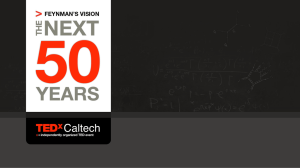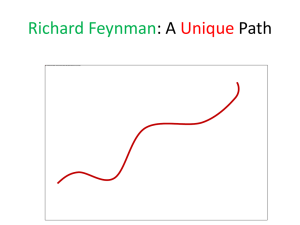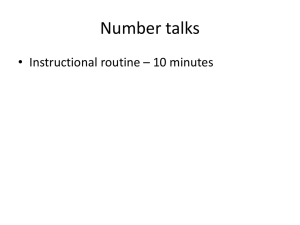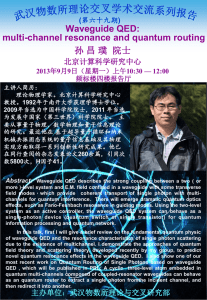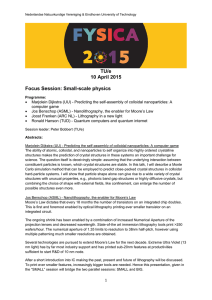Quantum Geometry: a reunion of Physics and Math
advertisement
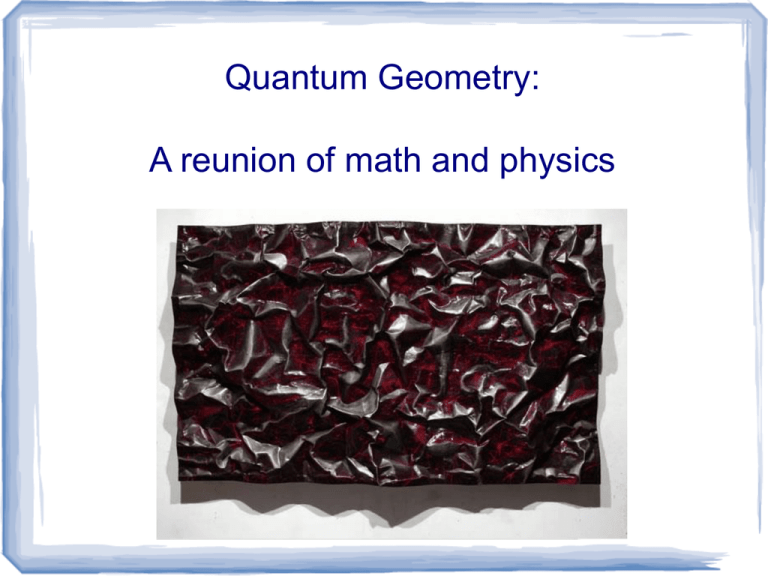
Quantum Geometry:
A reunion of math and physics
Physics and Math are quite different:
Physics
Math
Although to an uninitiated eye
they may appear indistinguishable
Math: deals with abstract ideas which exist
independently of us, our practice, or our world
(Plato)
Physics: the study of the most fundamental
properties of the real world, especially motion and
change (Aristotle)
Mathematicians prove theorems and value
rigorous proofs.
E.g. Jordan curve theorem:
“Every closed non-self-intersecting curve on a
plane has an inside and an outside.”
Seems evident but is not easy to prove.
Physicists are more relaxed about rigor.
Since the times of Isaac Newton, physics is
impossible without math:
Laws of Nature are most usefully expressed
in mathematical form.
In a sense, physics is applied math.
Most of the time, physicists are “consumers” of math:
They do not invent new mathematical concepts.
And mathematicians usually do not need physics.
Μ→Φ
But once in a while physicists have
to invent new math concepts to describe what
they see around them.
Isaac Newton had to invent
calculus to be able to
formulate laws of motion.
F=ma
Here a is time derivative of velocity.
The invention of calculus was a revolution in
mathematics.
Relativity theory of Einstein did not
lead to a mathematical revolution.
It used the tools which were already available:
The geometry of curved space created by Riemann.
But quantum mechanics does require
radically new mathematical tools.
Some of these have been invented by mathematicians
inspired by physical problems.
Some were intuited by physicists.
Some remain to be discovered.
What sort of math does one need for
Quantum Physics?
Classical Mechanics
Observables (things we can measure) are
real numbers
Determinism
Positions and velocities are all we need to
know
Quantum Mechanics
Observables are not numbers: they do not
have particular values until we measure
them.
Outcomes are inherently uncertain, physical
theory can only predict probabilities of
various outcomes.
Cannot measure positions and velocities at
the same time (Heisenberg's uncertainty
principle).
Heisenberg's Uncertainty Principle
Δx is the uncertainty of position
Δp is the uncertainty of momentum (p=mv)
ℏ=6.626∙ 10-34 kg∙m2/sec is Planck's constant
The better you know the position of
a particle, the less you know about its
momentum. And vice versa:
How can we describe this strange
property mathematically?
The answer is surprising:
Quantum position and quantum
momentum are entities which violate a
basic rule of elementary math:
commutativity of multiplication
XP≠PX
Recall that ordinary multiplication of numbers is
commutative:
a b=b a
and associative:
a (b c)=(a b) c
One can often define multiplication of other entities.
It is usually associative, but in many cases fails to be
commutative.
Which other entities can be multiplied?
Example 1: functions on a set X.
A function f attaches a number f(x) to every
element x of the set X.
The product of functions f and g is a function
which attaches the number f(x)‧ g(x) to x.
This multiplication is commutative and associative.
Example 2: rotations in space.
Multiplying two rotations is the same as doing
them in turn. One can show that the result is again
a rotation. This operation is associative but not
commutative.
Another difference between the two examples is
that functions on a set X can be both added and
multiplied, but rotations can be only multiplied.
When some entities can be both added and
multiplied, and all the usual rules hold,
mathematicians say these entities form a
commutative algebra.
Functions on a set X form a commutative algebra.
When all rules hold, except commutativity,
mathematicians say the entities form a
non-commutative algebra.
Quantum observables form a non-commutative
algebra!
This is a mathematical reflection of the Heisenberg
Uncertainty Principle.
But there are many more non-commutative algebras
than commutative ones.
Just like there are more not-bananas than bananas.
Bananas
Not bananas
There are many special cases, where we know
the answer. Say, for a particle moving on a line, we
have position X and momentum P.
Their algebra is determined by the following
“commutation relation”
XP-PX=iℏ
where i is the imaginary unit, i2 =-1.
But how do we find suitable multiplication rules in
other situations?
To find the right algebra, we can try
to use the Correspondence Principle
of Niels Bohr:
Quantum physics should
become approximately
classical as ℏ
becomes very small.
Slight difficulty: ℏ has a particular value, how can
one make it smaller or larger?
But this is easy: imagine you are a god and can
choose the value of ℏ when creating the Universe.
A Universe with a larger ℏ will be more quantum.
A Universe with a smaller ℏ will be more classical.
Tuning ℏ to zero will make the Universe completely
classical.
Conversely, we can try to start with a classical
system and turn it into a quantum one,
by “cranking up” ℏ.
Classical
Quantum
correspondence
quantization
This is called quantization.
Let's recap.
To describe a quantum system mathematically,
we need to find the right non-commutative algebra.
We can start with the mathematical description of
a classical system and try to “quantize” it by
cranking up ℏ. This is called quantization.
But is there enough information in
classical physics to figure out how to
quantize it?
R. Feynman argued
that the answer is “yes”.
His argument relied on something called the
“path-integral”.
Roughly:
Quantum answer is obtained by
summing contributions from all
possible classical trajectories.
Each trajectory
contributes eiS/ℏ
Some call it sum over histories.
This argument made most physicists happy.
In fact, physicists use Feynman's
path-integral all the time.
But there is a problem: it makes no
mathematical sense.
Until recently, most mathematicians
regarded path-integral with
skepticism.
This did not bother physicists, because their
mathematically suspect theories produced
predictions which agreed with experiment,
sometimes with an unprecedented accuracy.
For example, the gyromagnetic ratio for the electron:
gexp=2.00231930436...
experiment
gtheor=2.00231930435...
theory
On the other hand, in the 1950s and 1960s,
there was a revolution in mathematics
associated with the names of Grothendieck, Serre,
Hirzebruch, Atiyah, and others.
Alexander Grothendieck
(1928-2014)
Physicists paid no attention to it whatsoever.
“In the thirties, under the demoralizing influence of
quantum-theoretic perturbation theory, the mathematics
required of a theoretical physicist was reduced to a
rudimentary knowledge of the Latin and Greek alphabets.”
(R. Jost, a noted mathematical physicist.)
“Dear John, I am not interested in what today's
mathematicians find interesting.”
(R. Feynman, in response to an invitation from
J. A. Wheeler to attend a math-physics conference
in 1966.)
“I am acutely aware of the fact that the marriage
between mathematics and physics, which was so
enormously fruitful in past centuries, has recently
ended in divorce.”
Freeman Dyson, in a 1972 lecture.
But soon afterwards, things began to change.
1978: mathematicians Atiyah, Drinfeld, Hitchin and
Manin used sophisticated algebraic geometry to solve
instanton equations, which are important in physics.
1984: physicists Belavin, Polyakov, and Zamolodchikov
used representation theory of Lie algebras to learn
about phase transitions in 2d systems.
Physicists started to pay attention.
The advent of supersymmetry (1972) and modern
string theory (1984) further contributed to the flow of
ideas from math to physics.
1986: Calabi-Yau manifolds are important for physics,
to study them one needs tools from modern
differential geometry and algebraic geometry.
E. Witten, A. Strominger, G. Horowitz, P. Candelas,
J. Polchinski, J. Harvey, C. Vafa, P. Ginsparg, and others.
The turning point came about 1989.
E. Witten uses quantum theory to define invariants
of knots.
Mirror symmetry for Calabi-Yau manifolds is
discovered (various authors).
Mathematicians started to pay attention.
All these results were deduced by thinking about
path-integrals.
So perhaps one can make sense of the path-integral,
at least in some situations?
This is when Maxim Kontsevich
burst onto the scene.
Maxim took the path-integral
seriously and showed how to
use it to derive new
mathematical results.
I will focus on one striking example: the solution of
the quantization problem for Poisson manifolds.
The next portion of the talk will be more technical...
The quantization problem
Start with a classical system described by a
commutative algebra A
Use the information contained in the
classical system to turn it into a noncommutative algebra B
Correspondence principle: B depends on a
parameter ℏ so that for ℏ=0 it becomes A
Here is a motivating example: start with an
algebra of functions of two variables X and P.
The functions must be nice: polynomials, or
functions which have derivatives of all orders.
Then postulate a multiplication rule such
that XP-PX=i ℏ.
If we denote AB-BA=[A,B], then [X,P]=iℏ.
[A,B] is called the commutator of A and B.
If it vanishes for all A and B, the multiplication rule is
commutative.
Otherwise, it is non-commutative.
In classical theory, [A,B]=0 for all observables A and B.
In quantum theory it is not true. So how can we figure
out which observables cease to commute after
quantization?
Additional information used: ``Poisson bracket''.
The set of functions of classical observables
X and P has a ``bracket operation”:
To a pair of functions f(X,P), g(X,P) one
associates a new function
In particular, we can take f(X,P) and g(X,P) to be
simply X and P. Then
Now let us apply the substitution rule:
Get [X.X]=0, [P,P]=0, [X,P]=iℏ,
which is exactly right.
Poisson bracket thus seems to provide the
information needed to ``deform'' the algebra of
classical observables (functions of X and P) into a
non-commutative algebra of quantum X and P.
But does it, really?
Problem is, X and P are not available, in general.
Instead, one has a space whose points are
possible states of a classical system (so called
Phase Space).
Phase space can be flat:
But it can also be curved:
What are X and P here?
In general, X and P are just some local coordinates
on our phase space M. There are lots of possible
choices for them locally, but no good choice globally.
Instead of a simple formula for a Poisson bracket,
we have some generic bracket operation
taking two function f and g as arguments and
spitting out a third function.
This bracket operation is called the Poisson bracket.
It is needed to write down equations of motion in
classical mechanics:
Here H(X,P) is the Hamiltonian of the system
(i.e. the energy function).
The Poisson bracket must have a number of
properties ensuring that equations make both
mathematical and physical sense.
Properties of the Poisson bracket
{f,g} is linear in both f and g.
{f,g}=-{g,f}
{f ‧g,h}=f ‧{g,h}+g ‧{f,h} (Leibniz rule)
{{f,g},h}+{{h,f},g}+{{g,f},h}=0 (Jacobi identity)
So, can one take an arbitrary phase space, with an
arbitrary Poisson bracket, and quantize it?
That is, can one find a non-commutative but associative
multiplication rule such that
This is the basic problem of Deformation Quantization.
A space X with a non-commutative rule for
multiplying functions on X is an example of a
quantum space (or non-commutative space).
Quantum geometry is the study of such “spaces”.
The goal of Deformation Quantization is to
turn a Poisson space (a space with a Poisson
bracket) into a non-commutative space.
The idea to replace a commutative algebra of
functions with a non-commutative one and treat it
as the algebra of functions on a non-commutative
space has been very fruitful.
The motivation comes from the work of I. M. Gelfand
and M. A. Naimark in functional analysis (1940s)
and A. Grothendieck in algebraic geometry (1950s).
Israel Gelfand (1913-2009)
was a famous Soviet
mathematician
and Maxim's mentor.
Somewhat atypically for pure mathematicians of his era,
Gelfand maintained a life-long interest in physics.
(In fact, this was less atypical in the Soviet Union:
other names which could be mentioned are
V. I. Arnold, S. P. Novikov, and Yu. I. Manin.)
Some Poisson spaces look locally like a flat
phase space with its Poisson bracket. That is,
around every point there are local coordinates
Xi and Pi such that
For such spaces (called symplectic) existence of
deformation quantization was proved by
De Wilde and Lecomte (1983) and Fedosov (1994).
For symplectic spaces the existence of quantization
is very plausible on physical grounds.
But the general case seems much more difficult,
because Poisson bracket may ``degenerate'' at special
loci. It is not even clear why quantization should exist.
That is why it was a big surprise when Maxim proved
in 1997 that every Poisson manifold can be quantized:
M. Kontsevich, Deformation Quantization of Poisson
manifolds, Lett. Math. Phys. 66 (2003) 157-216.
Maxim deduced this from his Formality Theorem,
which I do not have time to explain.
How did Maxim do it???
His signature move: Feynman diagrams.
Feynman told us that to do quantum mechanics
one has to compute the path-integral (sum over histories)
But Feynman not only invented the
path-integral.
He also proposed a method to
compute it.
The idea is to disregard interactions of particles,
at least in the beginning.
Then the path-integral is “easy” to compute.
But the result is not very accurate, because we
completely neglected all interactions.
Next we assume that particles have interacted at most
once. The calculation is a bit more difficult, we get
a more accurate result.
Next we assume that particles have interacted at most
twice. This is an even harder calculation.
And so on. This is called perturbation theory.
Feynman's genius was to realize that each possible
way for particle to interact can be represented by a
picture.
After one draws all possible pictures, one computes a
mathematical expression for each picture, following
specific rules (Feynman rules).
Particle physics is, to a large extent, the art of
computing Feynman diagrams.
Sometimes, physicists need to evaluate hundreds or
thousands Feynman diagrams.
Some features of quantum systems are not captured
by Feynman diagrams.
They go beyond perturbation theory and therefore
are called non-perturbative features.
But the best understood part of quantum theory is
still perturbation theory, and all physicists (but hardly
any mathematicians) learn it.
Back to Deformation Quantization!
Maxim had the idea that the non-commutative
multiplication rule can be obtained from Feynman
diagrams.
The magic of the path-integral ensures that the rule
is associative, but not commutative.
A further twist: the path-integral that needs to be
turned into diagrams describes not particles,
but strings!
String theory has a reputation of being very
complicated and, somehow, new agey.
In fact, string theory has nothing to do with
yoga, auras and alternative medicine.
And the basic idea of string theory is simple:
take Feynman diagrams and thicken every particle
trajectory into a trajectory swept out by a string.
The picture on the right describes the history of two
loops of string merging into a single loop and them
parting their ways again.
There are stringy Feynman rules which translate
the picture on the right into a mathematical
formula for the probability of this process.
One can also have bits of string instead of loops.
In this picture two bits merge into one and then
break apart again:
Bits of string are called open strings, loops are called
closed strings.
For Deformation Quantization, one needs to use
open strings.
In the “usual” string theory, strings move in
physical space, perhaps with some extra hidden
dimensions added.
Maxim's idea was to consider strings moving in
the phase space of the classical system to be
quantized.
In his paper Maxim did not explain this, but just
wrote down the stringy Feynman rules.
The fact that these rules give rise to associative product
looked like magic.
Later A. Cattaneo and G. Felder showed how to
derive these Feynman rules from a path-integral
for open strings.
String theory
Feynman rules
Deformation Quantization
Varieties of Quantum Geometry
•
•
Non-commutative geometry:
–
Quantization of phase space ⋎
–
Hidden dimensions may be non-commutative
(A. Connes)
Stringy geometry
–
Mirror symmetry ⋎
–
Hidden dimensions in non-perturbative string
theory (M-theory, strings in low dimensions) ⋎
Quantized space-time
The idea that physical space-time should be
quantized and perhaps non-commutative is attractive.
Motivation: in quantum gravity, one cannot measure
distances shorter than some minimal length.
Reason: achieving a very accurate length
measurement requires a lot of energy, which may
curve the space-time and distort the result.
What is the structure of space-time at very short
length and time scales?
Is it non-commutative? Is it stringy?
It is a safe bet that answering these physical questions
will require entirely new math.
